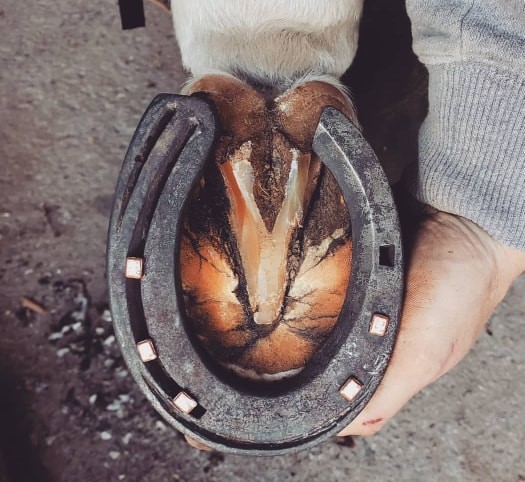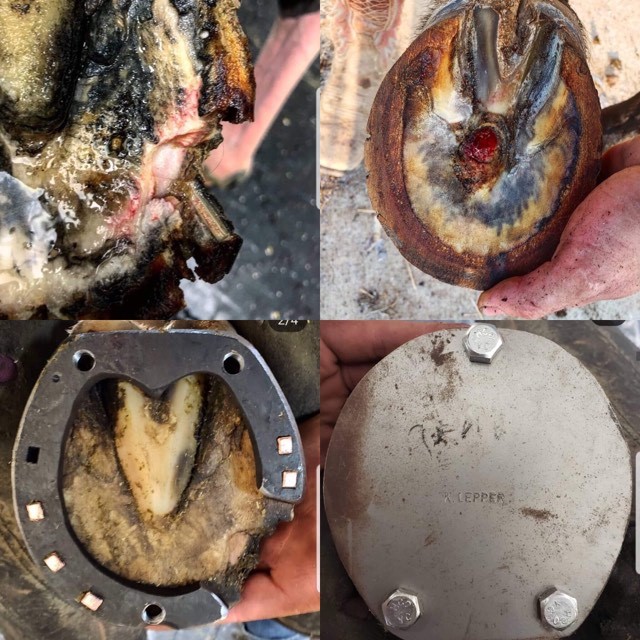No hoof, no horse; it’s a statement we all in the horse industry have heard before, but what is the truth behind it? How important is proper hoof care to the longevity of not only our horses’ competitive lives but their lives in general? I sat down with AFA Certified Journeyman Farrier Kayla Lepper to indulge in all things hoof, shoes, and farrier. I have spent hours learning from Kayla, and my hope is that those of you reading this will take away some new knowledge as well!

Collateral ligament shoe: this horse tore a ligament on the lateral side, so that side of the shoe is wider to prevent sinking in soft footing and promote healing. Photo: Kayla Lepper
JN: How do you become an AFA Certified Journeyman Farrier? How long does the process take?
Kayla: To become a CJF, you first must complete the CF (certified farrier) level. The journeyman consists of a 3 part exam, a written test over the anatomy of the limb and hoof, a practical exam (shoeing a horse to the AFA standards in 2 hours with handmade shoes) and a forging portion where the farrier hand makes a bar-shoe from straight bar-stock to fit a hoof in 35 minutes. The standards are high, and the exam isn’t easy. Any farrier that is going through the process or has passed should be highly respected.
JN: What is the difference in a Certified Farrier and a Non-Certified one?
Kayla: A certified farrier is someone that has gone above and beyond for their clients and horses. In the US, you don’t have to be certified to shoe horses, so if your farrier has gone through that process, you know they want to better themselves and improve their work. There are also great farriers that are not certified, but if you’re looking for a new farrier and don’t know much about them, if they are certified, you will at least know they have passed shoeing and written tests and have a certain level of education.
JN: I know that you compete in some unique competitions exclusive to farriers, can you elaborate on those?
Kayla: Most of the contests I attend are shoemaking contests. The judge has specimen shoes, and you’re trying to make that exact same shoe in the allotted time. The top four to five from the shoemaking classes go on to the final day where you shoe a horse in handmade shoes. It’s a timed event that is judged off quality.

Onion heel: this horse has low crushed heels. These protect the heels and allow them to float in soft footing acting like a wedge. Photo: Kayla Lepper
JN: How many contests have you competed in and how have you placed?
Kayla: I started competing two years ago and have competed several times. I have moved up from the novice level to the open in that short time frame. Of course, as you move up, the shoes get harder and harder! I have won a division one high point buckle, a division two high point hammer, and several ribbons!
JN: You recently traveled abroad to expand your knowledge further. Can you tell me a little about your travels and the difference in shoeing in the United States and abroad?
Kayla: The biggest difference is in the UK a farrier must be qualified to work on horses. Our journeyman farriers are equivalent to their diploma, so I was able to work on horses there. I did learn some little tips and tricks to make my job easier shoeing every day, but overall it is the same. It doesn’t matter what country you’re in; it’s still a horse that just needs a correct shoe job.
JN: What is the most complex hoof issue you have fixed with corrective shoeing?
Kayla: A couple of things with the wording of that question. As farriers we generally cannot “fix” things, it’s usually more of managing it for life or managing it until the hoof heals. I also try not to make things too complicated, especially if it doesn’t have to be. A lot of times simple is better, and a farrier can achieve similar results through multiple ways of shoeing. I choose the simplest way that is best for the horse. I have worked on founder cases, grown out quarter cracks, and a keratoma removal (with a vet of course).

Hospital plate: a metal pad that goes over the shoe and threaded with bolts for easy access to clean a wound, and to keep pressure off the compromised area. Examples of feet that need a plate, a shoe that would be used, and the plate. Photos: Kayla Lepper
JN: How do you assess new clients on the first visit before beginning a treatment plan and a regular schedule?
Kayla: It’s very important that my clients stay on a schedule that I set for them. Without a proper schedule, you’re no longer maintaining your horse’s feet; you’re trying to recover them. Before working on horses, we go over how I like to schedule, pricing, the horse’s behavior, and any special needs the horse may have.
JN: What is your advice for horse owners/trainers from a farrier’s standpoint?
Kayla: My advice would be to make sure you have a good farrier on your team and listen to them. Value their professional opinion; we have spent hours upon hours continuing our education and try our best to do the best job possible on every horse. Questions and concerns are fine, but you shouldn’t have to tell your farrier how to shoe your horse. Be confident in their abilities. You want someone works well with your vet if that need ever arises, and you want them to understand what the vet is talking about. Everyone on the same page is important.
JN: If there is one thing you would want people to take away from this interview, what would it be?
Kayla: What I want people to take away from this is that an educated farrier is a very valuable part of your team. After all, the saying is no foot, no horse!
If there’s one thing I know, it is that a great farrier is hard to come by, but I for one will always do best by the horses in my care to ensure that they have one. I implore you to do the same.
